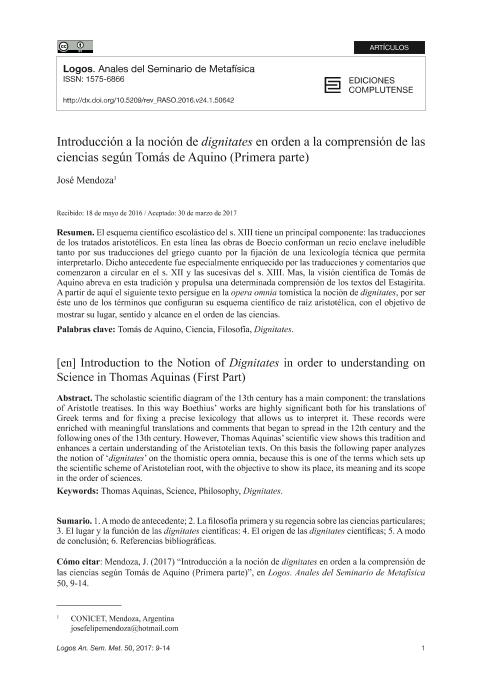Mostrar el registro sencillo del ítem
dc.contributor.author
Mendoza, José María Felipe

dc.date.available
2019-02-07T21:24:59Z
dc.date.issued
2017-03
dc.identifier.citation
Mendoza, José María Felipe; Introducción a la noción de dignitates en orden a la comprensión de las ciencias según Tomás de Aquino (Primera Parte); Universidad Complutense de Madrid; Logos. Anales del Seminario de Metafísica; 50; 3-2017; 9-14
dc.identifier.issn
1575-6866
dc.identifier.uri
http://hdl.handle.net/11336/69739
dc.description.abstract
El esquema científico escolástico del s. XIII tiene un principal componente: las traducciones de los tratados aristotélicos. En esta línea las obras de Boecio conforman un recio enclave ineludible tanto por sus traducciones del griego cuanto por la fijación de una lexicología técnica que permita interpretarlo. Dicho antecedente fue especialmente enriquecido por las traducciones y comentarios que comenzaron a circular en el s. XII y las sucesivas del s. XIII. Mas, la visión científica de Tomás de Aquino abreva en esta tradición y propulsa una determinada comprensión de los textos del Estagirita. A partir de aquí el siguiente texto persigue en la opera omnia tomística la noción de dignitates, por ser éste uno de los términos que configuran su esquema científico de raíz aristotélica, con el objetivo de mostrar su lugar, sentido y alcance en el orden de las ciencias.
dc.description.abstract
The scholastic scientific diagram of the 13th century has a main component: the translations of Aristotle treatises. In this way Boethius’ works are highly significant both for his translations of Greek terms and for fixing a precise lexicology that allows us to interpret it. These records were enriched with meaningful translations and comments that began to spread in the 12th century and the following ones of the 13th century. However, Thomas Aquinas’ scientific view shows this tradition and enhances a certain understanding of the Aristotelian texts. On this basis the following paper analyzes the notion of ‘dignitates’ on the thomistic opera omnia, because this is one of the terms which sets up the scientific scheme of Aristotelian root, with the objective to show its place, its meaning and its scope in the order of sciences.
dc.format
application/pdf
dc.language.iso
spa
dc.publisher
Universidad Complutense de Madrid

dc.rights
info:eu-repo/semantics/openAccess
dc.rights.uri
https://creativecommons.org/licenses/by-nc-sa/2.5/ar/
dc.subject
Tomàs de Aquino
dc.subject
Ciencia
dc.subject
Filosofia
dc.subject
Dignitates
dc.subject.classification
Estudios Religiosos

dc.subject.classification
Filosofía, Ética y Religión

dc.subject.classification
HUMANIDADES

dc.title
Introducción a la noción de dignitates en orden a la comprensión de las ciencias según Tomás de Aquino (Primera Parte)
dc.title
Introduction to the Notion of Dignitates in order to understanding on Science in Thomas Aquinas (First Part)
dc.type
info:eu-repo/semantics/article
dc.type
info:ar-repo/semantics/artículo
dc.type
info:eu-repo/semantics/publishedVersion
dc.date.updated
2018-12-19T14:43:02Z
dc.journal.volume
50
dc.journal.pagination
9-14
dc.journal.pais
España

dc.journal.ciudad
Madrid
dc.description.fil
Fil: Mendoza, José María Felipe. Universidad Nacional de Cuyo. Facultad de Filosofía y Letras. Instituto de Filosofía. Centro de Estudios Filosóficos Medievales; Argentina. Consejo Nacional de Investigaciones Científicas y Técnicas. Centro Científico Tecnológico Conicet - Mendoza; Argentina
dc.journal.title
Logos. Anales del Seminario de Metafísica
dc.relation.alternativeid
info:eu-repo/semantics/altIdentifier/url/http://revistas.ucm.es/index.php/ASEM/article/view/56832
Archivos asociados
